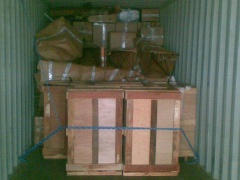Household and Personal Effects
| Infobox on Household and Personal Effects | |
|---|---|
| Example of Household and Personal Effects |  |
| Facts | |
| Origin | - |
| Stowage factor (in m3/t) | - |
| Humidity / moisture | - |
| Ventilation | - |
| Risk factors | See text |
Household and Personal Effects
Contents
Description
Household goods are goods and products used within households. They are the tangible and movable personal property placed in the living rooms, dining rooms, kitchens, family rooms, great rooms, bedrooms, bathrooms, recreation rooms, hallways, attics, and basements and other rooms of a house.
Examples of household goods include air conditioners, baby items, baking dishes, beds/bedframes, blankets, bedding, linens, towels, blenders, mixers, bookcases, books, bureaus, dressers, wardrobes, cabinets, can openers, chairs, clothes dryers, coffee makers, computers, cooking utensils, couches, sofas, loveseats, sectionals, sofa beds, curtains, curtain rods, drapes, decorative items, desks, dishes, dishwashers, entertainment centers, fans, freezers, (drinking) glasses, hand tools, hutches, irons and ironing boards, lamps, lawn chairs, (table) linens, love seats, mattresses, (home) medical equipment, microwave ovens, mirrors, pillows, pots and pans, refrigerators, rugs, sewing machines and notions, silverware (flatware), sheets, sofas, sectionals, sofa beds/futons, space heaters, stereos and radios, tables toasters and toaster ovens, tools, towels, toys, televisions, vacuum cleaners, and washer/dryers.
Personal property is generally considered private property that is movable, as opposed to real property or real estate. In the common law systems personal property may also be called chattels or personalty. In the civil law systems personal property is often called movable property or movables – any property that can be moved from one location to another. This term is in distinction with immovable property or immovables, such as land and buildings. Movable property on land, that which was not automatically sold with the land, included for example larger livestock (wildlife and smaller livestock like chickens, by contrast, was often sold as part of the land).
Shipment / Storage / Risk factors
One of the principal factors to be considered by the surveyor is the proximate cause of damage, which is, in many cases, inadequate or careless packing. In this context there are a number of specific points to be noted, for which the following may be a useful guide.
China and Glass – To save time, a packer will often stack a quantity of plates without interleafing the necessary packing materials. As china is extremely susceptible to chipping, breakage, etc., damage can often occur which can easily be mistaken for physical impact. Lids, stoppers, etc., should be wrapped individually.
Electrical and Mechanical Appliance – It is essential that the packers secure all free moving parts, i.e. revolving drums, etc., to avoid internal impact damage. Where a washing machine or freezer, etc., has been used as a loading base, the surveyor should try to confirm that the surface was adequately protected.
Floor coverings – See Floorings
Furniture – Corrugated cardboard manufactured by the sulphite process is frequently used to protect polished surfaces. Sweating and/or exposure to water or pressure causes damage to the surface along the lines of corrugation. Even if lightweight paper is inserted this will still occur. Waxed or waterproof paper does not allow free ventilation and may cause staining and loosening of veneers, due to condensation. Glue used in the manufacture of corrugated paper may soften and mingle with the finish on the furniture, leaving an alkaline scar.
Furniture with fragile legs or highly polished surfaces should not be used as loading bases unless the latter are adequately protected. Damage to furniture, particularly pieces with a lacquered finish, can be caused by the use of adhesive tape or labels.
The surveyor should examine broken and cracked surfaces of china, glass and furniture to determine whether the break or crack is of recent origin. Humidity which is often found in loose packing materials such as straw, encourages mildew, which can damage wooden and metal furniture. During the drying-out process, mould may form and surveyors should take care not to confuse this with mould directly caused by water.
When furniture is transported it is susceptible to climatic changes which can cause cracking, warping or splitting. However, this can also occur during storage in a warehouse or private residence where there is central heating. Where wardrobes, chests, etc., have been used as containers, often by the owner, breakage of legs, drawers and joints can often occur due to overloading.
Linen and Clothing – This is often owner-packed into sealed plastic/polythene bags, which can cause condensation. This should not be mistaken for water damage.
Paintings – Methods of packing vary considerably, usually according to the value. Where paintings are framed and glass-fronted, adhesive tape should be used to minimize the damage to canvas, etc., by glass breakage. In addition, the pieces should be wrapped individually, preferably in water-resistant paper. Unframed canvases should be packed so that painted surfaces do not make contact. Obviously, works of considerable value should be crated individually, the frames protected – on each corner, at least – and the crate lined with water-resistant paper.
Upholstery and Carpets – Latex/foam backed carpets should be rolled, not folded. Folding will result in breakage of the backing and permanent creasing of the carpet pile. Upholstered pieces should be protected from any ropes/strings used by suitable packing materials. There is tendency to be more lenient with regard to personal removal goods compared with commercial shipments and this is understandable in that removals can include items of sentimental value rather than appreciable intrinsic value. For removal of goods a valued inventory prepared at the time of effecting insurance is of great advantage in the event of a claim arising.
If under-insurance is apparent then average should be applied to the adjusted claim.











